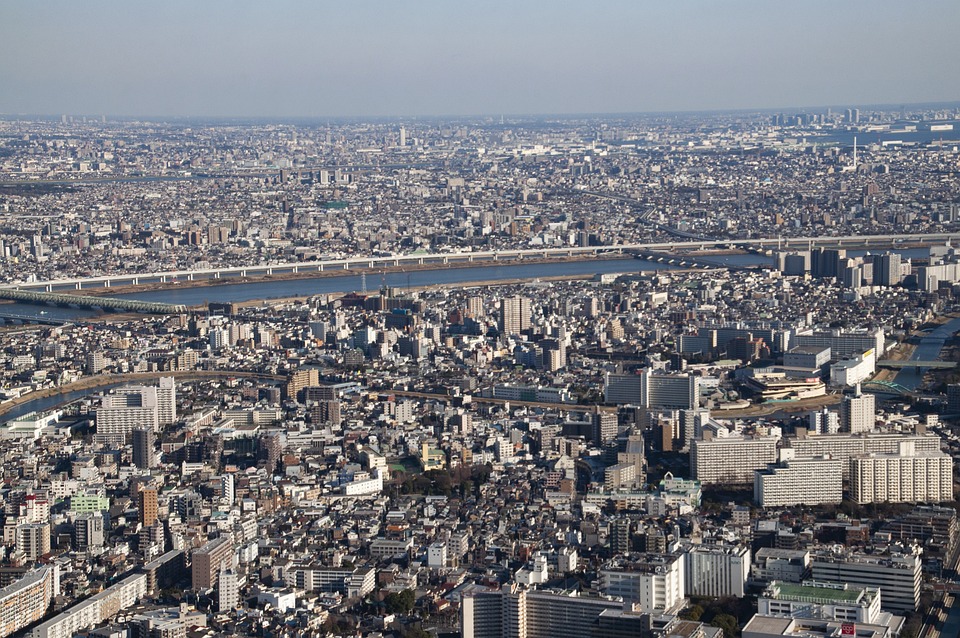
5.10 Impacts of Urbanization
2 min read•january 8, 2023
Mark Little
Mark Little

Image Courtesy of Pixabay
Urbanization is an increase in the number of people living in cities and towns. With more people in cities and towns, there are changes in the land use and economic development in the area. Potential reasons for the increase in urbanization include population growth, economic development, and changes in transportation and communication technologies.
Urbanization affects a natural biogeochemical cycles with the changing balance of increased human populations.
Impact to Natural Cycles
Because of the increased number of people in an area, the natural resources in the area are stressed, such as the availability of freshwater. Urbanization affects the nitrogen cycle by influencing plant growth by a change in nitrogen availability in soils. The water cycle is impacted in that structures like buildings or parking lots prevent water percolation and reduces the abilities of water to occur naturally in the environment.
The carbon cycle is impacted by the burning of petroleum based energy sources or fossil fuels that increase the amount of atmospheric CO2. In addition to creating more CO2, the process of building man made structures results in deforestation, further reducing the number of plants to capture the CO2.
Urban Sprawl
When urban growth spreads to rural areas and seems to have no limits in the urban areas, it can be called urban sprawl. The perception is that there is very little planning for the expanding commercial and housing areas. This unplanned growth puts a lot of stress on the environment and often leads to environmental problems like water pollution, reduction of available water supply, habitat loss and problems with proper waste disposal.
Urbanization can bring a number of benefits, such as increased access to education, healthcare, and employment opportunities. It can also lead to economic growth and development, as urban areas often have a higher concentration of businesses and industries. However, urbanization can also have negative impacts, such as congestion, pollution, and the loss of natural areas and biodiversity.
To mitigate these negative impacts, it's important for cities to plan for and manage urbanization in a way that promotes sustainable development. This can involve strategies such as investing in public transportation, promoting green spaces and energy-efficient buildings, and limiting sprawl. 🎥 Watch: Environmental Science Stream - Sustainability
Key Terms to Review (15)
Atmospheric CO2
: Atmospheric CO2 refers to the concentration of carbon dioxide gas in Earth's atmosphere. It is a greenhouse gas that contributes to global warming and climate change.Biogeochemical cycles
: Biogeochemical cycles are natural processes that involve the cycling of elements or compounds through living organisms and their environment.Carbon Cycle
: The carbon cycle is the movement of carbon atoms between living organisms (plants and animals), the atmosphere (as carbon dioxide), bodies of water (as dissolved carbon dioxide), and fossil fuels (as stored carbon).Deforestation
: Deforestation refers to the clearing, removal, or destruction of forests. It involves the permanent conversion of forested areas into non-forest land for various purposes such as agriculture, urbanization, or logging.Energy-efficient buildings
: Energy-efficient buildings are structures that are designed and constructed to minimize energy consumption and reduce their environmental impact. They incorporate various technologies and practices to optimize energy use, such as efficient insulation, lighting systems, and renewable energy sources.Fossil Fuels
: Fossil fuels are energy-rich substances formed from ancient organic matter buried deep within the Earth's crust. They include coal, oil, and natural gas. Fossil fuels are burned to release energy but also release carbon dioxide and other pollutants into the atmosphere.Green spaces
: Green spaces are areas within cities or communities that are predominantly covered in vegetation, such as parks, gardens, or forests. They provide natural habitats for wildlife, recreational opportunities for people, and contribute to the overall well-being of the environment.Habitat Loss
: Habitat loss refers to the destruction or degradation of a natural environment where organisms live. It is primarily caused by human activities such as deforestation, urbanization, and pollution.Nitrogen Cycle
: The nitrogen cycle is the process by which nitrogen is converted between its various chemical forms in the environment. It involves nitrogen fixation, nitrification, assimilation, ammonification, and denitrification.Public transportation
: Public transportation refers to shared modes of transportation available for use by the general public. It includes services like buses, trains, trams/streetcars, subways/metros/undergrounds, ferries/boats/ships that operate on scheduled routes with fixed stops or stations.Sustainable development
: Sustainable development refers to the practice of meeting present needs without compromising the ability of future generations to meet their own needs. It involves balancing economic growth, social progress, and environmental protection for long-term well-being.Urban sprawl
: Urban sprawl refers to the uncontrolled expansion of cities into surrounding rural areas. It often leads to low-density development with increased infrastructure demands and environmental impacts.Urbanization
: Urbanization refers to the increasing proportion of people living in urban areas compared to rural areas. It involves the growth and expansion of cities due to factors like population growth and migration.Water Cycle
: The water cycle refers to the continuous movement of water on, above, and below the Earth's surface. It involves processes such as evaporation, condensation, precipitation, and runoff.Water pollution
: Water pollution refers to the contamination of water bodies, such as rivers, lakes, and oceans, by harmful substances or pollutants. This can include chemicals, sewage, oil spills, and other waste materials that degrade water quality and harm aquatic life.5.10 Impacts of Urbanization
2 min read•january 8, 2023
Mark Little
Mark Little

Image Courtesy of Pixabay
Urbanization is an increase in the number of people living in cities and towns. With more people in cities and towns, there are changes in the land use and economic development in the area. Potential reasons for the increase in urbanization include population growth, economic development, and changes in transportation and communication technologies.
Urbanization affects a natural biogeochemical cycles with the changing balance of increased human populations.
Impact to Natural Cycles
Because of the increased number of people in an area, the natural resources in the area are stressed, such as the availability of freshwater. Urbanization affects the nitrogen cycle by influencing plant growth by a change in nitrogen availability in soils. The water cycle is impacted in that structures like buildings or parking lots prevent water percolation and reduces the abilities of water to occur naturally in the environment.
The carbon cycle is impacted by the burning of petroleum based energy sources or fossil fuels that increase the amount of atmospheric CO2. In addition to creating more CO2, the process of building man made structures results in deforestation, further reducing the number of plants to capture the CO2.
Urban Sprawl
When urban growth spreads to rural areas and seems to have no limits in the urban areas, it can be called urban sprawl. The perception is that there is very little planning for the expanding commercial and housing areas. This unplanned growth puts a lot of stress on the environment and often leads to environmental problems like water pollution, reduction of available water supply, habitat loss and problems with proper waste disposal.
Urbanization can bring a number of benefits, such as increased access to education, healthcare, and employment opportunities. It can also lead to economic growth and development, as urban areas often have a higher concentration of businesses and industries. However, urbanization can also have negative impacts, such as congestion, pollution, and the loss of natural areas and biodiversity.
To mitigate these negative impacts, it's important for cities to plan for and manage urbanization in a way that promotes sustainable development. This can involve strategies such as investing in public transportation, promoting green spaces and energy-efficient buildings, and limiting sprawl. 🎥 Watch: Environmental Science Stream - Sustainability
Key Terms to Review (15)
Atmospheric CO2
: Atmospheric CO2 refers to the concentration of carbon dioxide gas in Earth's atmosphere. It is a greenhouse gas that contributes to global warming and climate change.Biogeochemical cycles
: Biogeochemical cycles are natural processes that involve the cycling of elements or compounds through living organisms and their environment.Carbon Cycle
: The carbon cycle is the movement of carbon atoms between living organisms (plants and animals), the atmosphere (as carbon dioxide), bodies of water (as dissolved carbon dioxide), and fossil fuels (as stored carbon).Deforestation
: Deforestation refers to the clearing, removal, or destruction of forests. It involves the permanent conversion of forested areas into non-forest land for various purposes such as agriculture, urbanization, or logging.Energy-efficient buildings
: Energy-efficient buildings are structures that are designed and constructed to minimize energy consumption and reduce their environmental impact. They incorporate various technologies and practices to optimize energy use, such as efficient insulation, lighting systems, and renewable energy sources.Fossil Fuels
: Fossil fuels are energy-rich substances formed from ancient organic matter buried deep within the Earth's crust. They include coal, oil, and natural gas. Fossil fuels are burned to release energy but also release carbon dioxide and other pollutants into the atmosphere.Green spaces
: Green spaces are areas within cities or communities that are predominantly covered in vegetation, such as parks, gardens, or forests. They provide natural habitats for wildlife, recreational opportunities for people, and contribute to the overall well-being of the environment.Habitat Loss
: Habitat loss refers to the destruction or degradation of a natural environment where organisms live. It is primarily caused by human activities such as deforestation, urbanization, and pollution.Nitrogen Cycle
: The nitrogen cycle is the process by which nitrogen is converted between its various chemical forms in the environment. It involves nitrogen fixation, nitrification, assimilation, ammonification, and denitrification.Public transportation
: Public transportation refers to shared modes of transportation available for use by the general public. It includes services like buses, trains, trams/streetcars, subways/metros/undergrounds, ferries/boats/ships that operate on scheduled routes with fixed stops or stations.Sustainable development
: Sustainable development refers to the practice of meeting present needs without compromising the ability of future generations to meet their own needs. It involves balancing economic growth, social progress, and environmental protection for long-term well-being.Urban sprawl
: Urban sprawl refers to the uncontrolled expansion of cities into surrounding rural areas. It often leads to low-density development with increased infrastructure demands and environmental impacts.Urbanization
: Urbanization refers to the increasing proportion of people living in urban areas compared to rural areas. It involves the growth and expansion of cities due to factors like population growth and migration.Water Cycle
: The water cycle refers to the continuous movement of water on, above, and below the Earth's surface. It involves processes such as evaporation, condensation, precipitation, and runoff.Water pollution
: Water pollution refers to the contamination of water bodies, such as rivers, lakes, and oceans, by harmful substances or pollutants. This can include chemicals, sewage, oil spills, and other waste materials that degrade water quality and harm aquatic life.
Resources
© 2024 Fiveable Inc. All rights reserved.
AP® and SAT® are trademarks registered by the College Board, which is not affiliated with, and does not endorse this website.